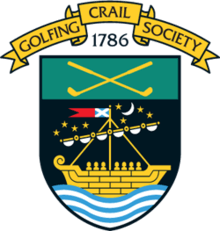Despite circumstantial evidence that the game was played in this area as far back as 1760, The Crail Golfing Society wasn’t formally established until 1786 when eleven local gentlemen held their first meeting on the 23rd of February of that year. They played their golf over what was then known as the Sauchope Links, under a dual agreement for grazing and golf and this made them the 6th oldest recorded golf club in the world behind Royal Burgess, The Royal Company of Edinburgh Golfers (Muirfield), The Royal & Ancient Golf Club (St. Andrews), Bruntsfield Links Golfing Society, Royal Musselburgh and Royal Aberdeen.
The first competition to be played over what became known as the Balcomie Links occurred in 1856, and it wasn’t until 1895, a mere 109 years after its foundation did Tom Morris get to lay his hands on the golf course when redesigning the then 9-holes. This, interestingly, was the same year as the first ever US Open. Five years later, the course was extended to an 18-hole layout, this time by the legendary Old Tom Morris himself. A lady’s club was elected at Crail as early as 1901, but it wasn’t until 1996 that their club was officially incorporated into the Crail Golfing Society, ten years after the Societies 200th anniversary. Two years later, Crail opened their 2nd eighteen holes, the Craighead course. Designed by American architect Gil Hanse, this was his first project outside of the USA. Hanse produced a challenging yet contrasting links to Balcomie. So successful was the opening that within two years, the course hosted the R&A Junior Open. It has since hosted International matches, the Seniors Home Internationals, and the Scottish Amateur Team Championships.
Balcomie is, in a word, ‘quirky.’ That is the only way you can describe a golf course that has three par fives, nine par fours, and six par threes! This is ultimately reflective of the fact that when the golf course was laid down, it took account of the natural lie of the land more than any consideration for a balanced scorecard. The walled boundaries of the course come into play as often as the coastline, demarcating its limits. We love the mix of holes on Balcomie, a course that has you reaching for every club in the bag at least once. While not long, it requires great accuracy and ball placement, and the inevitable coastal wind is ever-present.
The par three’s focus your attention at Crail Golfing Society. A mix of uphill and downhill holes, cross wind and partially blind. There are also back-to-back par threes at 13 & 14. The first of which has a significant uphill carry to contend with. The 214yard 13th is one of the toughest par three holes that you are ever likely to play coupled with a devilishly undulating and challenging green – a bogey here is not the worst score! It is followed then by the beautiful downhill 14th. From the tee, this hole offers a spectacular panoramic view of Crail and the surrounding region and is very much a ‘Kodak’ moment on your trip. The putting surface, which looks like a dime piece from the tee box, is also surrounded by devilish pot bunkers. These are two fabulous holes to enjoy on your round.
Crail can often be overlooked by visitors who base themselves in St. Andrews, but there is no doubting the quality of the course, the welcome and the experience at this wonderful club. In our opinion, no golf vacation in Scotland, and in particular to the Kingdom of Fife, should miss out on an opportunity to play the wonderful Crail. If you would like to see how Crail fits into a golf vacation in the St. Andrews area, then take a look at our “St. Andrews Golf Experience” tour for some ideas.

